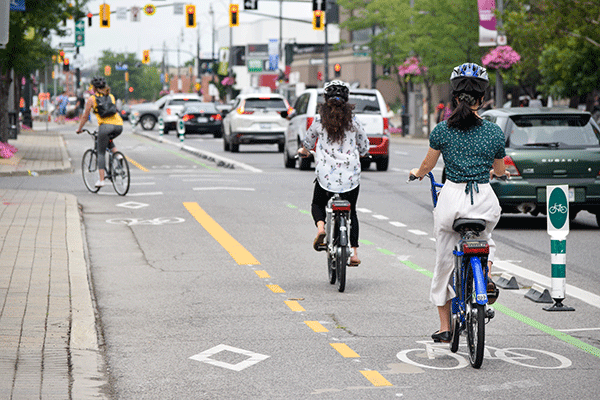Public Health Supporting Complete Streets in Hamilton

THE PROJECT
For over a decade, Hamilton Public Health Services (HPHS) has been promoting active modes of transportation to reduce the risk of chronic diseases in the City of Hamilton. This work has involved direct participation in the development of a Pedestrian Mobility Plan, a Cycling Master Plan, and the 2018 City-Wide Transportation Master Plan which included a Complete, Livable, Better (CLB) Streets – Policy and Framework. The CLB Streets policy set priorities for Hamilton’s approach to Complete Streets and gave rise to the development of a Completes Streets Design Manual that was approved in 2022.
BACKGROUND
Wrapped around the west end of Lake Ontario, Hamilton is a port city with a population of 569,355. Located nearly 60 kilometres southwest of Toronto, Hamilton is part of the Greater Toronto and Hamilton Area (GTHA). While the local economy was historically built around the steel industry and heavy manufacturing, in recent years, it has been shifting towards the service sector with a heavy emphasis on health sciences.
Hamilton is a single tier municipality. Promoting and protecting the health of the community is the responsibility of Hamilton Public Health Services (HPHS) which is a part of the city’s Healthy and Safe Communities Department.
THE PROCESS
“About 12 years ago, we conducted a situational analysis within public health to decide how best to influence the levels of physical activity in our community which can have a significant impact on population health,” offered Don Curry, Health Promotion Specialist with HPHS. “At that time, the evidence was telling us that we needed to focus more on creating environments that foster and support physical activity, rather than on individual behavioural change, if we really wanted to increase the levels of physical activity at a community level.”
Guided by a growing body of scientific evidence that suggested that levels of physical activity were influenced by the design of neighbourhoods, streets and communities, HPHS began cultivating relationships with key staff in the departments responsible for land use and transportation planning within the city.
“We recognized that if we wanted to influence public policies related to transportation and land use planning, we needed to work with people in those departments. We needed to understand their processes and we needed them to understand public health’s perspective in the design of streets, neighbourhoods, and communities,” explained Curry.
Staff in public health informed themselves about the impact of the built environment on public health. They began reviewing land use planning documents such as the Official Plan, secondary plans, and subdivision plans. They also became engaged directly in the development of transportation plans such as the Pedestrian Mobility Plan, the Cycling Master Plan, and the Transportation Master Plan.
“We have now established solid working relationships with our colleagues in the Sustainable Mobility team in Planning and Economic Development who have responsibility for developing transportation plans for the City,” explained Curry. “We have a seat at the table along with City staff from other departments to provide input at various steps in the process.”
“Within public health, there are staff with different areas of expertise. While I am focused primarily on physical activity, others focus on injury prevention, healthy eating, air quality, climate change, and health equity,” explained Curry. “We consult with each other when providing comments on land use and transportation planning documents, or when wrestling with complicated issues that arise in meetings with other departments.”
Staff found that the 2014 report, Improving Health by Design, released by the Medical Officers of Health from the Greater Toronto and Hamilton Area (GTHA), helped City Councillors, staff in other departments, and the public to understand how land use and transportation planning can impact the health of the community.

That report estimated that traffic-related air pollution in the GTHA was causing negative health outcomes valued at $4.6 billion per year, while physical inactivity and obesity were producing negative health outcomes valued at $4 billion per year. It explained how health benefits valued at about $2 billion per year could be created by the investments proposed for public transit and active transportation by Metrolinx in the GTHA.
“We have cited this report many times when commenting on land use and transportation documents,” noted Curry. “By estimating the number of negative health impacts and applying an economic value to them, it helped people to appreciate the significance of the health impacts, and the importance of addressing public health’s concerns.”
In 2015, Hamilton’s City Council directed staff to incorporate health into the transportation planning process. The Vision of the new Transportation Master Plan includes the following commitment: “To provide a comprehensive and attainable transportation blueprint for Hamilton as a whole that balances all modes of transportation to become a healthier city”.
“Like other transportation plans, we were able incorporate health messages throughout the 2018 Transportation Master Plan. But with this plan, we were also able to include a background document on ‘The Role of Public Health in the Built Environment’ to further highlight how health is affected by the built environment, “explained Curry.
The 2018 Transportation Master Plan commits the city to develop complete streets “that balance the needs of all users regardless of age, ability or mode of transportation”. It also recommends that guidelines be developed to support the operationalization of that commitment. This led to the development of the Complete Streets Design Manual that was endorsed in July 2022.
“The pandemic prevented Public Health Services from having the same amount of involvement in these processes for the last two years, but we hope to bring a renewed commitment to the table as we settle back into our former positions,” offered Curry. “We plan to address health equity and climate resiliency more directly in our work in the coming years.”

THE OUTCOMES
Public health staff have developed strong working relationships with staff in the Sustainable Mobility team in Planning and Economic Development.
They helped create a Pedestrian Mobility Plan and a Cycling Master Plan that includes health goals and messaging.
They helped to create a Transportation Master Plan that includes health goals and messaging that commits the city to develop complete streets.
“There are so many benefits associated with complete streets,” offered Curry. “They foster physical activity, reduce vehicle-related injuries and deaths, decrease emissions of air pollutants and greenhouse gases, and reduce social inequities. They can also reduce traffic congestion and increase community resiliency.”
LESSONS LEARNED
HPHS staff have learned some important lessons over the years:
- To influence public policies that are the responsibility of another department, staff need to cultivate relationships with staff in those departments and learn about their processes.
- It is important to be a partner at the table to understand the complexities of the issues discussed, appreciate how decisions are made, and ensure that health evidence is considered when decisions are made.
- Transportation planning in a large urban centre is complex. There are many technical issues to be considered – such as the utilities that are under the roads, the trees beside the roads, the needs of emergency workers, street cleaners, and garbage trucks – all on top of the needs of pedestrians, cyclists and drivers. To influence transportation policies and plans, public health staff need to understand the complexities and be involved in the discussions about how to balance the competing needs.
Prepared by Kim Perrotta, MHSc, Executive Director, CHASE
Last modified: February 13, 2023
